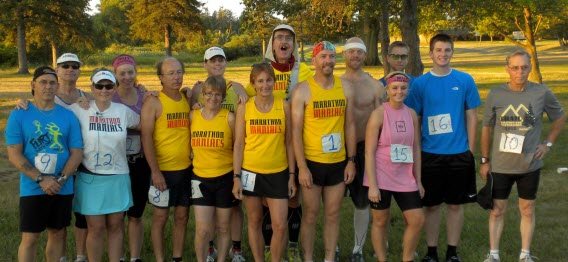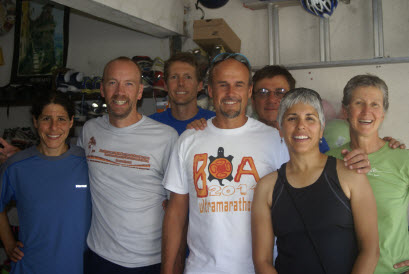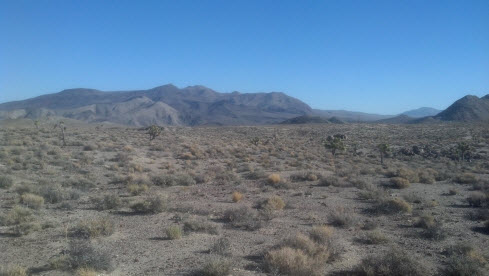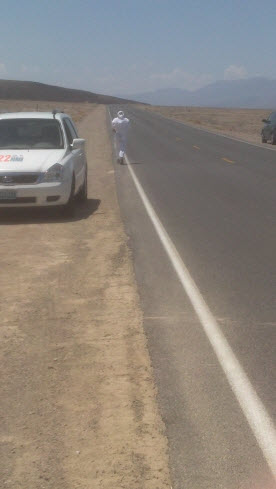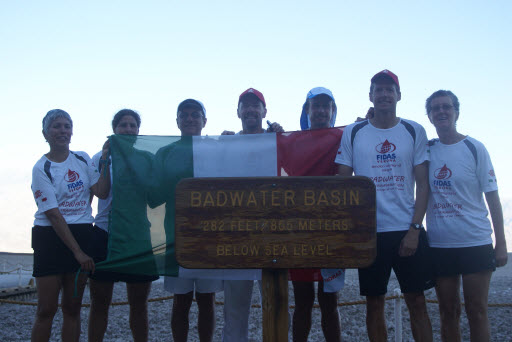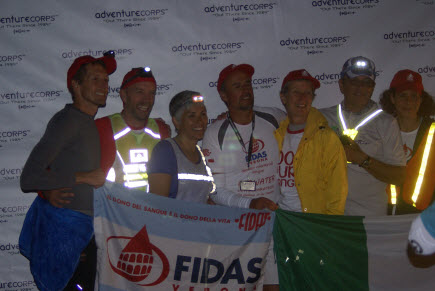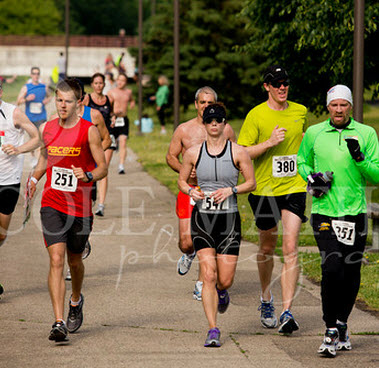15:27:56
(2/XY overall)
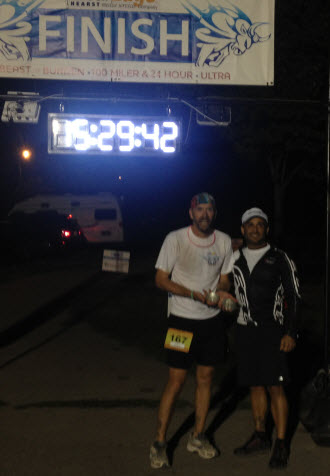
Well, this is a story of two acts, a joyous drama that crescendos then drops to a horrible low point where, for a brief time I truly consider that I might just have run my last ultra, ever. This one could make a good movie, actually.
Let us go quickly back to the
Winter Beast of Burden (hereafter known as BoB) back in January of 2012. It was my worst 100 mile race with a time just over 21 hours. I had made several mistakes including not consuming any caffeine, not using my headlight much and listening to the wrong things on my mp3 player.
So in April of 2012, I had an opportunity to redeem myself at the
Philly 100 race. I started out a little slower and fixed the obvious mistakes I made at BoB and ran a 16:59, good enough for a win. After that race, I knew that I could really start to make a mark in the ultrarunning world if I trained a little smarter. My sights were firmly set on the next race, the Summer Beast of Burden, which just happened to be on my 40th birthday.
I spent the summer pioneering (I think, for I have never heard of anyone else doing it) a new 100 mile training strategy. There are plenty of people who training for ultras running by running 100-120 miles per week usually consisting of 10-15 miles each day with longer 25-35 mile runs on the weekends. What I wanted to do was try to mimic race conditions a little better, getting my body used to the slog of 100 mile races. So, in the peak of my training, 1 weeks mileage record might look like this: 26 - 0 - 29 - 0 - 35 - 0 - 50. The theory went that my body had gotten used to 26 mile runs after a zillion marathons so doing a 15 miler was not doing me much good training for a 100 mile race. Understand, these long days were never fast (4 hour marathon pace or so) and I mimicked race conditions as much as possible including run fuel and such. Train as you fight, they say. The more your sweat in training, the less you bleed in battle. Pick your motto.
I have known for a long time that I am not that tough mentally as a racer and I am the first one to ‘sluff off’ in a race when the going gets tough. The idea here, was that I train hard and then when I get to the starting line, I shut my brain ‘off’ and let muscle memory and my body do the work. This concept was first tested at the Philly 100 and that test went quite well,so why not push it?
One day I was doing my really long run for the week (50 miles) and I was feeling good and noticed that I still had some time before I had to go get my kids from school, so I decided to extend my run to 62 miles. Again, this was a gentle pace with a healthy amount of walking involved, but still, it was a 100k ‘training run’. I have always been blessed with few injuries and I was smart in my training, taking precautions and listening to my body, but I was always willing to push it to the limit, but never going past that limit. I was feeling great going into this race, about as good as I could have.
My 100 miler taper is usually 3 week long with weekly mileages of 75, 40, and 15 leading up to the race. Tapers are always tough for me, especially when I am consistently doing 110-120 miles leading up to it as I end up feeling bloated, fat and slow as the race nears. This race was no different, but I knew that was ‘standard’ so was not too concerned.
<insert ominous music here> Eight days before the race, I went out for my last long 14 mile run and I stepped off to pee and I happen to get some poison ivy on me. No problem, right? A couple of days later I head to my doctor (it was getting pretty bad) and because he wants me to recover from it soon, I get a shot of some steroid, some prednisone pills and some steroid cream. Not enough to give me an advantage mind you, but enough to tamp down the poison ivy (not completely, however) Does anyone mention possible side effects? Nope. <fade out ominous music>
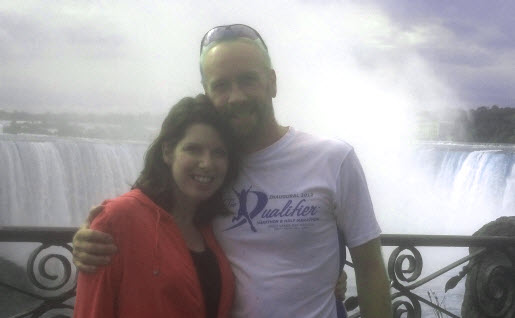
Misty and I take off Thursday after her workday ended and we crash for the evening in London, Ontario, a little over halfway to Lockport, NY, where the race is located. We decided to make it sortof a honeymoon weekend since the kids were all with their ‘other’ parents. Friday morning we head for the Canadian side of Niagara Falls, reliving our third date a little over three years ago. We had a great time there, a pleasant lunch at the Hard Rock Cafe, then on to Buffalo to see the latest Jason Bourne flick. It was totally relaxing, and I was feeling great. I was amazingly calm considering how focused I have been the last few months on this race. While on the Canadian side, we stopped at Guinness Book of World Records Museum. Did you know that if you have a World Record, you get in for free? It’s true.
Later Friday afternoon we headed to the unofficial pre-race meal at a small local restaurant to chat with some of the race volunteers, crew and fellow runners. As is par for such events, the conversations were fun and informative, everyone having opinions on various other ‘Hundos’ around the country. There were a few people who (as a group it seems) came up from Florida to take on the Beast. When they found out it was going to get into the 50’s in the evening, they shivered. It’s all about perspective, I guess. Fellow ultramarathoner and great friend Kai showed up a little later to and by 9 pm, the three of us were back in the hotel room for the night. Kai snores a little, but everyone seemed to get a good nights rest. So far, so good.
The race start is not until 10 am, so we slept until 6ish, taking our time rising and then headed down for a nice hot hotel breakfast of eggs, sausage, yogurt and coffee. There were at least six other runners staying at the same hotel partaking as well. More conversation, mostly now focused on how awesome a day it was going to be to run.The coffee was especially delicious to me because I had stopped all caffeine consumption 10 days out so that when I drank Mt. Dew, Red Bull and 5 hour energy drinks during the race, they would be a little more potent. And yes, that little plan worked too.
We arrived at the start line about 80 minutes before the start, check in, drop our aid station bags, relax, and chat more with other runners swapping stories. The last few minutes before ultras is always more laid back than marathons. It could be the distance, it could be the people, who knows.
With about 90 seconds left before the start, Sam the Race Director comes on the PA and tells everyone it is my 40th birthday and then yes, all the runners and crew who were there sang me ‘Happy Birthday’. That was totally cool and awesome.
While the weather was not ‘perfect’, it was pretty darn awesome in my opinion. The high was for the day was about 80 and the low in the mid 50’s. For August in New York, we were happy. Previous years it has gotten into the 90’s and got people bad. Having trained for and then crewed for Badwater this summer, I was quite happy with the conditions. What is very interesting is that the DNF rate this year was quite high, almost 40%. I had a conversation with the race director long after the race and he thought it was because people went out way too fast and when the temp hit its high rough 30% into the race, the runners began to suffer mightily.
 Loop 1 (0-25 miles) 3:23
Loop 1 (0-25 miles) 3:23
So I knew I wanted to start slow but steady so I ran with front group pretty much the entire first loop. In that group was me, another accomplished ultrarunner (PR 16:40), World Class runner Valmir Nunes (Badwater course record holder) and 3 people attempting their first 100. At the Philly 100, I ran with some people slower than me just to get in my groove and it worked. It is nice to run with someone in the beginning because it makes those initial miles go by quicker. I wanted to get into my ‘rut’ of the race as soon as possible. I was glad to have these people to talk to and it was a hair faster than I wanted to go, but training had been so good and I knew that if I wanted to PR this day, I should be going this pace. Friendly banter continued until almost mile 35 before I was finally alone.
The BoB course is a 12.5-out-12.5-back x 4 course with major aid at the turn and minor aid (no crew) about halfway out. At the 12.5 mile turn I get to see my lovely crew, Mistique. She is an awesome crew member because she listens to directions, which is what you want. Give her instructions and they are done, perfectly. And did I mention that she is really cute, too? I changed shoes quick (I wore the wrong pair at the beginning), swallowed 2 electrolyte pills, 2 amino acid pills, ate a cup of fruity jello, downed a can of V8 energy and swapped out my handheld bottle for a full one. All that, and I was out of there within 90 seconds of my arrival. A well oiled machine is what we were and I felt great, but granted I was only 1/8 into the race. In my (now full) handheld was gatorade laced with carbo-pro and electrolyte powder and in the pouch was a small tortilla with almond butter spread. A new race fuel for me (tested in training of course) which was 200 calories that can be downed in 4 easy bites. I would have 5 of these by days end. Considering I can almost never keep down solid food during ultras, this was the big coup of the race, my stomach ‘accepting’ this caloric contribution.
As I rolled back to the 25 mile point (start/finish), I downed another can of V8 energy, more pills, more jello, new (filled) handheld and another tortilla. I also laid down and elevated my feet for a little while as well. I learned this trick from a friend at Badwater and it helped a lot this day. It’s a simple concept (also tested in training) where every 90-120 minutes you lie down and elevate your feet above for heart for 90 seconds. It is a good ‘reset’ of the blood in your legs and you feel a little refreshed afterward. Trust me, it works.

Loop 2 (25-50 miles) 3:39
Early in this loop I finally was on my own, so I pulled out my ipod for the ‘slow’ music of the day, the audio from the movie The Godfather. It took me awhile to get all the way through it as I would listen for a few minutes then stop it to chat with the aid station workers and other runners on the course. I would end up getting through The Godfather and half of The Godfather Part 2 before going to rock and roll at mile 62.5.
I finally took my first short walk break around mile 32. Knowing I would be powerwalking occasionally, I also trained for this in two ways. One is when you are walking in an ultra, keep your hands ‘above’ your waist. If you let your arms drop, you tend to walk slower. With your arms up in almost a running position, you naturally walk faster. The other trick was how to make the transition from walking to running. That (especially late in the game when you are tired) is always hard. To combat this, you don’t go straight from walking to running, you go from walking to skipping. You know, like a little girl playing in the park on a summer day. Do that for 4-5 steps then start running and you would be amazed how much easier the transition is. You look silly, but who the heck cares? Not I, obviously.
<more ominous music, but subtle> Somewhere around mile 35, I urinated for the first time. It was a little orange. I thought about it and (erroneously) that I might have taken too many electrolytes, and thought my kidneys were in overdrive so I backed off the levels I was consuming and drank more water. Lots of water. Yet I still wasn’t peeing that often. Hmm… <music fades>
I came upon mile 50 and felt just fine. My legs were all good, brain and stomach just ducky. All that good news and the fact that I had only urinated once in 7 hours just slipped my mind. Change shoes, elevate feet, red bull, pills, go.
 Loop 3 (50-75 miles) 3:45
Loop 3 (50-75 miles) 3:45
Those long training days were paying off as I had been on my feet for over 7 hours and still felt fresh. Race start was late (10am) but I was running so fast, I still had quite a bit of daylight in front of me and I didn’t grab my ‘techno’ mp3 player until the mile 62.5 turn. I was starting to get a little tired and I knew I needed the music to help me through that.
As I was headed back on loop 3, the sun reached the horizon and as I was running along the Erie Canal the mosquitoes came out something fierce. I ran through seemingly hundreds of swarms of baby mosquitoes, young enough so not biting-viable, but numerous enough that I swallowed my share of them. When I finally turned on my headlamp at about mile 69, the swarms looked like falling snow which of course reminded me of the winter BoB 100 race. I laughed out loud, no joke.
<Music>So finally at mile 68 it was time to urinate again and I was a little afraid it would still be orange. I got red. Umm.. What I should have done was stop. Right there. DNF. Do not pass go, do not collect $200. What I did do was keep running and keep my red urine a secret. My kidneys felt fine all day and I am dumb fool, so I only stop when I feel pain. I am running well under PR pace and my legs feel great, so why stop? <back to happy background music>
I roll into the mile 75 turn now grabbing single servings applesauce packets instead of tortillas. Those packets were great and my stomach loved the taste of them, even after the jello wasn’t sitting that well anymore.
Loop 4 (75-100 miles) 4:25
At this point, I knew I had 5.5 hours to do the last 25 miles and get a PR and I was feeling great. I knew it might be awhile before I had such good race conditions. By this time I was doing 30 min run/5 min walk cycles and still maintaining a good clip. Almost every soul (except seriously elite ultrarunners) slow at 100 mile races, but this slow deceleration was great from my personal background. Put another way, I was doing great.
At the last turn, mile 87.5, I was rough. I felt terrible, but not because my kidneys (they felt fine, seriously) just beaten down and tired. Well, I felt like you should feel after 87.5 miles of running. I grabbed some more apple sauce, drank some red bull, downed my last pills and one more cup of jello/fruit, said thank you to the wonderful aid station workers since it was my last time seeing them, and I was out the door. Just hold it together. I managed 25 min running before my next walk break, a small victory in and of itself.
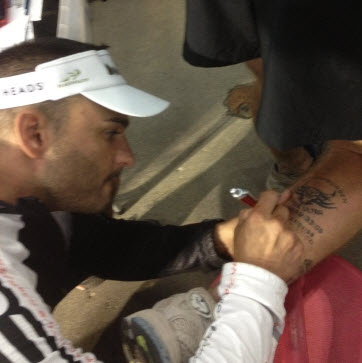
I hit the mile 93.5 aid station and saw some good friends who came up from the Cleveland area to help out. They were congratulating me on my birthday (congratulations I was receiving all day) and they asked me if I wanted a beer and I said ‘sure’. They were surprised the guy in second place was willing to have one this close to the finish. I only drank about 2/3 of it and then headed out for the last hard miles. The last miles of races are always tough, but what was awesome is that I felt this way only after 90+ miles, not after 50. I was having a really hard time keeping my run time longer than my walk breaks but still managed, barely. I had decided at about mile 85 I was cool with a 15:45 finish time, but as the last half loop was drawing to a close and sub 15:30 was possible, I dug deep in my soul and picked up the pace. Official time: 15:27:56. A new 100 mile PR by an hour and 5 minutes. I felt like I normally do at such a time, tired but very happy. I drank a little water and a cup of chicken broth and there was lots of congrats all around including with the winner, Valmir Nunes and RD Sam (whom deserves awesome kudos for running a great race) The race director personally wrote (with pen) my new time in the appropriate spot on my leg tattoo. I felt great and was glad to sit down and relax. I was making fine (slow) conversation, and if you didn’t know any better, you would think everything was good, considering. I knew I wanted to hang out for a bit to eat here so I could sleep better. I never sleep well right after a Hundo as my body is working overtime to rebuild my muscles. Hopefully with plenty of fresh fuel it might be easier for me to sleep.
For you movie aficionados, this is the ‘false ending’ to the story. The movie script here would have this note: “Music is light and happy, then transitions to low rumble and ominous as camera slowly zooms in on Mark’s face as his expression turns from happy to concern to uncomfortable”
After about 10 minutes sitting there, I started feeling nauseous. Valmir the Great (who speaks broken english) tells me I should go out, put my finger down my throat and puke it up (he does this all by hand gestures, funny stuff) and everyone agrees that’s a great idea so I go out and do just that. Chicken broth and water up come. Valmir comes out with a blanket, and in broken english is asking me how I am doing, and covering me up with a blanket,. The temperature is in the lows 50’s, but I just stopped vigorous exercise so I was a little cold. A kind soul, Karin, who is friends with the official race folk (RD and head volunteers) decided to come down, hang out and help where she could. She has coaching experience and she came over to see how I was doing. She could tell by my low pulse (and me lying down in a bad way) that I needed fluids, quick. I sipped some small amount, then lied back down. Up a few minutes later, small drink, down. I barely moved in almost an hour and my pulse was still weak. Karin stayed with me the whole time, monitoring me and making sure I did not pass out as that would have been bad. Then I did bent over and tossed the water I had been barely holding down for the last hour. With little discussion, it was decided that I was off to the local hospital to get an IV. For those who know me, you will know how serious the situation was because I did not put up a fight at all. The hospital was close enough that Misty drove me the 2 miles and I was admitted into the ER just over an hour after I finished the race.

It took about 20 min of questions, paperwork, before I finally got an IV in me. They took some blood samples and I rested there, trying very hard not to pass out. I was trying to keep the mood light, even saying “there’s no place like home” to keep me awake. The ER nurse didn’t seem to have a sense of humor at all. Misty was very concerned but being calm knowing that her freaking out at all would make me worse. I love her so dearly.
After a few hours, Misty was out in her car sleeping (she had been up all day/night just like me) and the ER doctor came in and gave me the bad news. My heart enzymes were very elevated and they were afraid I might have also suffered a heart attack as the elevated enzymes indicate both kidney problems (I knew that one) and a possible heart attack. Did I mention that about 35 miles into the race my chest got tight and I thought little of it? He tells me they are going to fill out the paperwork and I would be headed to Buffalo (30 min away) to a cardiac specialist who is on call 24/7. While I am waiting for that (I was told it will be about an hour trip) and Misty not being there I went where my brain goes in such conditions, worst case. Quick. Here I am assuming I did have a heart attack and possible renal failure. I just turned 40. My ultra future was put in serious jeopardy. My cardiac doctor will probably tell me that I should stick to short races (like marathons). I begin to think that I just earned my last 100 mile tattoo. I would have a visual reminder everyday of something that once gave me great joy then ended suddenly, and not the way I wanted. Emotional train wreck was what I was becoming. I have gone from one of the best moments of my entire life (40th birthday and a HUGE hundo PR) to one of the lowest points I have ever been (You’re effectively done doing ultras) in about 3 hours. Considering the vast difference between this high and this low, my emotional state is understandable. Because I have my phone and I am not in the best place mentally, I decide to post my anguish on facebook. I am not quite sure why, I just did. Maybe I just needed to tell someone. Note to self, don’t ER and facebook at the same time. Wait until you know what is going on…
I finally call up Misty, wake her up and tell her to come in so I can give her the update. Through sobs, I explain what I have learned and the ‘worst case scenario’ of each component of the diagnosis, as it presently stands. Saying it outloud was almost worse.
The first good sign is when at 5 am, the ER doc tells me that I am NOT going to Buffalo after all and that the cardiac guy is coming on Monday at 9am (28 hours in the future), here at the hospital and I am going to be admitted to the ICU for ‘observation’. Gotta love the scientific method. As I come to find out, there is a easy way to test which cause (kidney problems or heart attack) caused the elevated enzymes. Load the guy up with IV fluid (6L, maybe?) let it settle and then test again. If the levels start heading towards normal, it was the kidneys only. If they remain high, it was the heart and still possibly kidneys. It’s a logic puzzle, you see.
I am moved to the ICU at about 6 am get more blood drawn, and meet the new kind folk there. At about 9 am, a sweet older polish woman (my doctor of the moment) comes to tell me about the newest batch of tests. I quiz her hard so I understand all of the information she is giving me. The levels did drop greatly towards normal between test 1 and test 2 and she says with high confidence that I will be ‘just fine’ in a day or so.
I ask her straight up if I had had a cardiac ‘event and she says that she is 90% sure that no, I was fine there. She asks me questions about why my kidneys might have been screwed up. She asked me if I drank the night before the race. I told her I did, and I usually do to help me sleep (true). She said ‘that might have contributed to it’. She then said steroids could also have caused the rhabdomyolysis, my official diagnosis. I admit that I have been on steroids to combat a nasty case of poison ivy I got last week. Her eyes light up, she points at me and says “Well, there ya go”. I ask ‘So this is a one time incident, no harm done, just a bad set of circumstances”? She said yes. I say “So as long as I keep a better eye on my pee and if it gets red, stop right there and seek medical attention I should not fear the long term effects of this event?” She says “Exactly”. If I wasn’t married, and her not 65, I would have jumped up and kissed her.
I still have to hang out for another 24 hours for them to observe me, just to be absolutely sure, but my mood is vastly better. Now I have to spend the rest of the day undoing the facebook hullabaloo I started. I was in a bad way, but not nearly as bad as first expected. I got to enjoy some hospital food which wasn’t that bad and I tell ya, IV drips are a good recovery ‘drink’.
Thirty minutes after the race officially ended (about 4:30 pm) Sam the Race Director himself shows up to see how I am doing, telling the ICU people he is my brother. He really is a nice guy and we have a good conversation about my day, the race in general, and conditions that led to me being in the ER which, it turns out were similar to something happened to him after an ultra. Twice. He also pointed out that if every finisher came over to the ER and had the same blood test done as I did, most would have similar elevated enzymes levels due the stress that was put on the heart. ER doctors have very little experience with ultrarunners, as generally we are freaky healthy and do not come to ER’s. What a great learning experience, for everyone.
I spent Sunday night in the hospital, sleeping quite hard which was no surprise. I was hoping to get out early, but feared I would be down the totem pole of priority as I got moved out of ICU into a ‘normal’ room at 2:30 am Monday as they needed the space. The doctor came in a little after 8 am to give me the latest. He was the third doctor I had talked to since I came in at 1:30 am the previous day and he was by far the most knowledgeable of the medical condition from which I suffered from. He did not know when he first came in that I had even run a 100 mile race and as soon as I told him, he rolled his eyes and said “Well that explains everything”. It was (almost) comical. He told me that my latest set of blood enzyme tests were still elevated but going in the right direction and that I could go home if I promised to follow up with my doctor back home. It took a little over an hour for all the paperwork to be filled out and needles yanked from my body and Misty and I finally got on the road and headed back to Michigan, getting home about 5 pm Monday.
Wow, what a weekend. While this is an educational weekend for sure, it was also exciting and eventful. I felt mortal, which is a good thing. I love running.






 This was my 5th official race as a pacer and this was as enjoyable as the others. I get to help people achieve their goals, I work on my own even pacing, (something everyone needs practice with) and I also got a great weekend with Misty. This was also the first marathon I have ever run in minimalist shoes, and so it marked the beginning of a new era in my running career.
This was my 5th official race as a pacer and this was as enjoyable as the others. I get to help people achieve their goals, I work on my own even pacing, (something everyone needs practice with) and I also got a great weekend with Misty. This was also the first marathon I have ever run in minimalist shoes, and so it marked the beginning of a new era in my running career.
 As we passed each mile marker, I would check the elapsed time against the pace chart and determine how many seconds difference between the two. Negative numbers meant we were under our projected time, positive meant we were over. For the first 13 miles, theat number fluctuated between -5 and +8. That is pretty much as even pace as you can get.
As we passed each mile marker, I would check the elapsed time against the pace chart and determine how many seconds difference between the two. Negative numbers meant we were under our projected time, positive meant we were over. For the first 13 miles, theat number fluctuated between -5 and +8. That is pretty much as even pace as you can get.
 Well, this is a story of two acts, a joyous drama that crescendos then drops to a horrible low point where, for a brief time I truly consider that I might just have run my last ultra, ever. This one could make a good movie, actually.
Well, this is a story of two acts, a joyous drama that crescendos then drops to a horrible low point where, for a brief time I truly consider that I might just have run my last ultra, ever. This one could make a good movie, actually. Misty and I take off Thursday after her workday ended and we crash for the evening in London, Ontario, a little over halfway to Lockport, NY, where the race is located. We decided to make it sortof a honeymoon weekend since the kids were all with their ‘other’ parents. Friday morning we head for the Canadian side of Niagara Falls, reliving our third date a little over three years ago. We had a great time there, a pleasant lunch at the Hard Rock Cafe, then on to Buffalo to see the latest Jason Bourne flick. It was totally relaxing, and I was feeling great. I was amazingly calm considering how focused I have been the last few months on this race. While on the Canadian side, we stopped at Guinness Book of World Records Museum. Did you know that if you have a World Record, you get in for free? It’s true.
Misty and I take off Thursday after her workday ended and we crash for the evening in London, Ontario, a little over halfway to Lockport, NY, where the race is located. We decided to make it sortof a honeymoon weekend since the kids were all with their ‘other’ parents. Friday morning we head for the Canadian side of Niagara Falls, reliving our third date a little over three years ago. We had a great time there, a pleasant lunch at the Hard Rock Cafe, then on to Buffalo to see the latest Jason Bourne flick. It was totally relaxing, and I was feeling great. I was amazingly calm considering how focused I have been the last few months on this race. While on the Canadian side, we stopped at Guinness Book of World Records Museum. Did you know that if you have a World Record, you get in for free? It’s true. Loop 1 (0-25 miles) 3:23
Loop 1 (0-25 miles) 3:23 Loop 3 (50-75 miles) 3:45
Loop 3 (50-75 miles) 3:45 I hit the mile 93.5 aid station and saw some good friends who came up from the Cleveland area to help out. They were congratulating me on my birthday (congratulations I was receiving all day) and they asked me if I wanted a beer and I said ‘sure’. They were surprised the guy in second place was willing to have one this close to the finish. I only drank about 2/3 of it and then headed out for the last hard miles. The last miles of races are always tough, but what was awesome is that I felt this way only after 90+ miles, not after 50. I was having a really hard time keeping my run time longer than my walk breaks but still managed, barely. I had decided at about mile 85 I was cool with a 15:45 finish time, but as the last half loop was drawing to a close and sub 15:30 was possible, I dug deep in my soul and picked up the pace. Official time: 15:27:56. A new 100 mile PR by an hour and 5 minutes. I felt like I normally do at such a time, tired but very happy. I drank a little water and a cup of chicken broth and there was lots of congrats all around including with the winner, Valmir Nunes and RD Sam (whom deserves awesome kudos for running a great race) The race director personally wrote (with pen) my new time in the appropriate spot on my leg tattoo. I felt great and was glad to sit down and relax. I was making fine (slow) conversation, and if you didn’t know any better, you would think everything was good, considering. I knew I wanted to hang out for a bit to eat here so I could sleep better. I never sleep well right after a Hundo as my body is working overtime to rebuild my muscles. Hopefully with plenty of fresh fuel it might be easier for me to sleep.
I hit the mile 93.5 aid station and saw some good friends who came up from the Cleveland area to help out. They were congratulating me on my birthday (congratulations I was receiving all day) and they asked me if I wanted a beer and I said ‘sure’. They were surprised the guy in second place was willing to have one this close to the finish. I only drank about 2/3 of it and then headed out for the last hard miles. The last miles of races are always tough, but what was awesome is that I felt this way only after 90+ miles, not after 50. I was having a really hard time keeping my run time longer than my walk breaks but still managed, barely. I had decided at about mile 85 I was cool with a 15:45 finish time, but as the last half loop was drawing to a close and sub 15:30 was possible, I dug deep in my soul and picked up the pace. Official time: 15:27:56. A new 100 mile PR by an hour and 5 minutes. I felt like I normally do at such a time, tired but very happy. I drank a little water and a cup of chicken broth and there was lots of congrats all around including with the winner, Valmir Nunes and RD Sam (whom deserves awesome kudos for running a great race) The race director personally wrote (with pen) my new time in the appropriate spot on my leg tattoo. I felt great and was glad to sit down and relax. I was making fine (slow) conversation, and if you didn’t know any better, you would think everything was good, considering. I knew I wanted to hang out for a bit to eat here so I could sleep better. I never sleep well right after a Hundo as my body is working overtime to rebuild my muscles. Hopefully with plenty of fresh fuel it might be easier for me to sleep.
